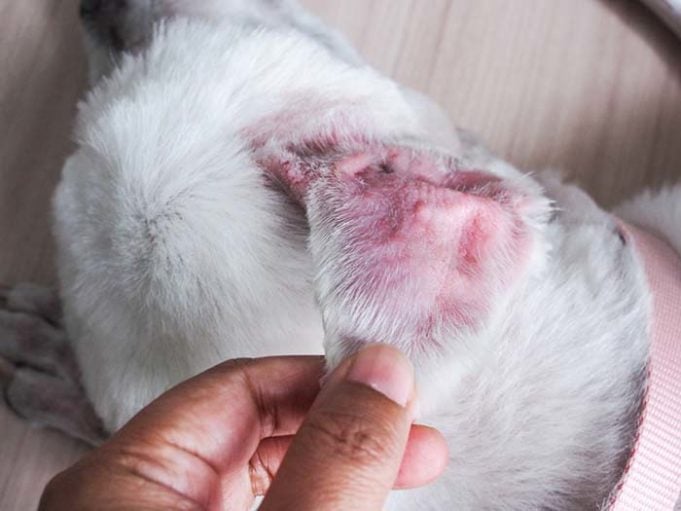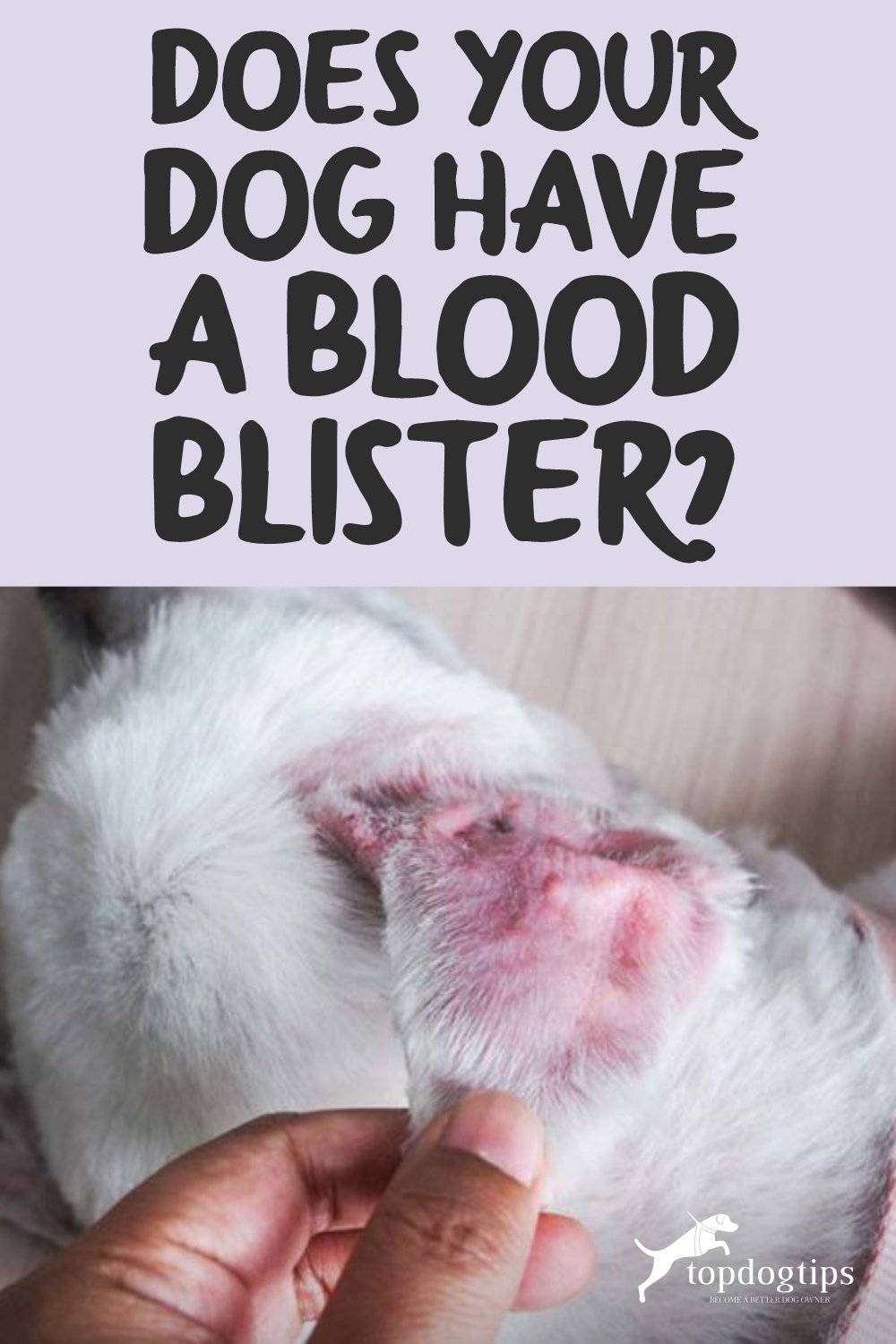Table of Contents
- What is a Blood Blister?
- What Causes Blood Blisters in Dogs?
- Can Dog Blood Blisters be Prevented?
- Should I Seek Veterinary Care?
- What Should I Do to Treat a Blood Blister on My Dog?
- Common Questions about these Blisters in Dogs
- What Does a Dog Blood Blister Look Like?
- How Do You Treat a Blood Blister on Dog?
- Why Does My Dog Have Blood Blisters?
Blood blisters, or hematomas, are blisters that form on your dog and are filled with blood. If you ever see a blood blister on your pooch, you may have some questions: What causes blood blisters?
Can blood blisters be prevented? Should I seek veterinarian care if I see a blood blister on my dog? What, if anything, should I do to treat a blood blister on my dog?

What is a Blood Blister?
Blood blisters are hematomas or blisters filled with blood that form under your dog's skin. The most common area for you to see a blood blister is on your dog's ears, but these blisters can form on other parts of the body as well.
The reason blood blisters are most commonly found on or near a dog's ear is that dogs that have ear infections or mites may scratch or shake their heads in response, causing the ear flaps to slap against their leader.
When this is done excessively, it can cause hematomas to form under the skin of the ears. This can lead to further scratching and head shaking and more hematomas.
Blood blisters are caused by irritation and excessive scratching; however, they can be painful and irritating to your dog.
If your dog finds blood blisters irritating and painful, they will be more likely to scratch the spot of the blister, which could cause it to become worse or infected.
What Causes Blood Blisters in Dogs?
As mentioned above, blood blisters are caused when your dog has a spot or spots that irritate them.
By scratching themselves repeatedly or shaking their heads vigorously, they can cause damage to the skin.
If the skin becomes damaged, a blister can form where blood collects under the skin.
Other symptoms of a blood blister include:
- Swelling of the area
- Redness of the area
- Deformation where the blister is located
- Avoidance of touch or pressure
- Discoloration of the skin and surrounding area
Your dog can worsen blood blisters if the dog repeatedly scratches or shakes its head, thus damaging the area further.
A damaged blood blister can rupture, causing your dog more pain and possibly infection.
Blood blisters can also happen internally; however, they are harder to notice and diagnose by a veterinarian.
Internal blood blisters can be caused by damage to your dogs, such as an accident, dog fight, or other bodily harm.
If your dog has an internal blood blister, the organ that it rests on could become damaged.
Even though there are not many signs that you can see, your dog may experience the following symptoms:
- Seizures
- Comas
- Neurological damage
- Organ failure
- Pain
- Incontinence
Can Dog Blood Blisters be Prevented?
You can avoid some blood blisters, but not all blood blisters can be prevented entirely.
If you notice that your dog is scratching or shaking its head excessively due to irritation, then you should seek veterinary care to help prevent a blood blister.
If your dog is experiencing an ear infection or skin infection, it is better to treat it before your dog causes a blood blister.
By avoiding the blood blister and taking care of the initial problem, you are protecting your dog from more pain and the potential of infection or worse injury.
To prevent your dog from an internal blood blister, try to keep them out of dog fights and away from any physical bodily harm that may cause internal injury.
Ways to do this include keeping them leashed when walking or in a fenced area outside.
Should I Seek Veterinary Care?
Even though blood blisters can heal independently, they can take a long time – several weeks or months.
Remember that they most likely cause your dog pain, and your dog is at risk of causing the blister to worsen or open and become infected if they have left to scratch the area or shake their head.
To avoid further damage to your dog, if you see a blood blister, seek veterinary care. A veterinarian is the best person to diagnose and treat a blood blister.
Not only can a veterinarian treat the original problem that caused your dog to scratch or shake and a blood blister to form, but they are also best suited to offer treatment. The different treatment options as:
Option 1: Depending on the location and size of the blood blister, your veterinarian may drain the hematoma of blood; however, draining sometimes isn't a perfect solution, as the area can refill with blood.
Option 2: To prevent blood from accumulating, it may be necessary to temporarily drain at the blister site.
Option 3: Surgery under anesthesia may be the next option, especially with internal hematomas near the skin. With surgery, the blood is drained, the clot is removed, and the area is sutured so that blood cannot re-enter the room.
Option 4: In cases of hematomas on the ears, the ears may be bandaged to prevent further slapping against the head, and your dog may have to wear an Elizabethan collar to prevent further damage.
What Should I Do to Treat a Blood Blister on My Dog?
 Do not, under any circumstances, try to drain or burst a blood blister on your own. This will only cause more damage to your dog because you could introduce bacteria into the already damaged area.
Do not, under any circumstances, try to drain or burst a blood blister on your own. This will only cause more damage to your dog because you could introduce bacteria into the already damaged area.
Suppose blood blisters are expected on or around your dog's ears and you have spoken to your veterinarian about waiting to seek treatment. In that case, they may recommend that you use the Elizabethan collar to see if the blister will go away on its own.
This treatment method is only suggested if the blood blisters are small, familiar, go away quickly, you have already spoken to your veterinarian about this course of treatment, and you know the potential risks of delaying treatment.
Common Questions about these Blisters in Dogs
If you still have some questions about this type of blister on your dog's body, the following answers should clear them up.
Remember, when in doubt, bring your dog to a doctor of veterinary medicine.
What Does a Dog Blood Blister Look Like?
One of these blisters will look like a normal blister but filled with blood. The area may also be red or swollen.
How Do You Treat a Blood Blister on Dog?
Never try to drain a blood blister yourself. You could cause more harm than good. Pet owners should always consult their vet before treating one of these hematomas.
The vet may ask you to wait and watch the blister to see if it disappears on its own. Or they may suggest draining it surgically. They would do so in a safe, sterile environment.
Why Does My Dog Have Blood Blisters?
Your dog will develop a blood blister if one of his blood vessels bursts. They are most common when your dog scratches an area or shakes hard.
This irritation may damage the blood vessels or the skin in some cases.
Blood blisters are widespread in your dog's ears because the blood vessels there are more fragile.
READ NEXT: 9 Ways to Improve Your Dog's Skin and Coat Health
WANT TO SHARE THIS…














